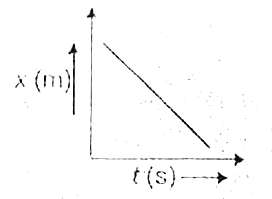Assertion : The average and instantaneous velocities have same value in a uniform motion.
Reason : In uniform motion, the velocity of an object increases uniformly
Both assertion and reason are true and reason is the correct explanation of assertion.
Both assertion and reason are true but reason is not the correct explanations of assertion.
Assertion is true but reason is false.
Both assertion and reason is false
The correct Answer is:(c )
To solve the assertion and reason question, we will analyze both statements step by step.
Step 1: Understand the Assertion
The assertion states that "the average and instantaneous velocities have the same value in a uniform motion."
- Explanation: In uniform motion, an object travels equal distances in equal intervals of time, meaning its speed does not change. Therefore, the average velocity (total displacement divided by total time) and instantaneous velocity (velocity at a specific moment) will be the same because the speed is constant throughout the motion.
Step 2: Understand the Reason
The reason states that "in uniform motion, the velocity of an object increases uniformly."
- Explanation: This statement is incorrect. In uniform motion, the velocity does not increase; it remains constant. Therefore, the reason does not support the assertion.
Step 3: Conclusion
From the analysis:
- The assertion is true because average and instantaneous velocities are equal in uniform motion.
- The reason is false because it incorrectly states that velocity increases in uniform motion.
Final Answer
The correct option is that the assertion is true, but the reason is false.
---
The assertion states that "the average and instantaneous velocities have the same value in a uniform motion."
The reason states that "in uniform motion, the velocity of an object increases uniformly."
From the analysis:
- The assertion is true because average and instantaneous velocities are equal in uniform motion.
- The reason is false because it incorrectly states that velocity increases in uniform motion.
The correct option is that the assertion is true, but the reason is false.
Topper's Solved these Questions
- MOTION IN A STRAIGHT LINEBOOK - NCERT FINGERTPS ENGLISHCHAPTER - MOTION IN A STRAIGHT LINEEXERCISE - Higher Order Thinking Skills
10 Videos
- MOTION IN A STRAIGHT LINEBOOK - NCERT FINGERTPS ENGLISHCHAPTER - MOTION IN A STRAIGHT LINEEXERCISE - NCERT Exemplar
6 Videos
- MOTION IN A STRAIGHT LINEBOOK - NCERT FINGERTPS ENGLISHCHAPTER - MOTION IN A STRAIGHT LINEEXERCISE - NCERT EXEMPLAR PROBLEMS
6 Videos
- MOTION IN A PLANE BOOK - NCERT FINGERTPS ENGLISHCHAPTER - MOTION IN A PLANE EXERCISE - Assertion And Reason
15 Videos
- OSCILLATIONS BOOK - NCERT FINGERTPS ENGLISHCHAPTER - OSCILLATIONS EXERCISE - Assertion And Reason
15 Videos
Similar Questions
Knowledge Check
For uniform motion :
Athe distance-time graph is a straight line parallel to the time axis.Bthe speed-time graph is a straight line inclined to the time axis.Cthe speed-time graph is a straight line parallel to the time axis.Dthe acceleration-time graph is a straight line parallel to the time axis.In uniform circular motion
AAcceleration is constantBMagnitude of acceleration is contantCTangential acceleration is zeroDTangential acceleration is not zeroFor a uniformly retarded motion, the velocity-time graph is :
Aa curveBa straight line parallel to the time axisCa straight line perpendicular to the time axis.Da straight line inclined to the time axis.
When is a body said to be in uniform motion?
View SolutionThe position - time (x−t) graph of an object in uniform motion is shown below, the velocity of object is

View SolutionDraw the x-t graph of an object in uniform motion.
View SolutionGive an example of motion in which speed remains uniform, but the velocity changes.
View SolutionWhat is the average velocity of a body in uniform circular motion ?
View Solution
